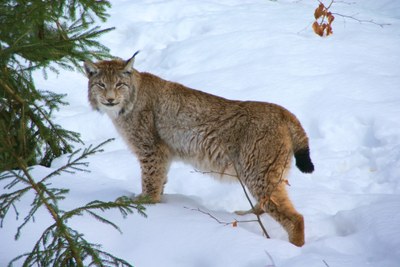Mapping habitat suitability directly from the Landsat archive
Julian Oeser, Marco Heurich, Cornelius Senf, Dirk Pflugmacher, Elisa Belotti, Tobias Kuemmerle
Summary: We show that Landsat-based spectral-temporal metrics can significantly improve habitat assessments for large mammals when compared to land-cover maps, better capturing fine scale variation and temporal dynamics in habitat conditions.
Abstract: Up-to-date and fine-scale habitat information is essential for managing and conserving wildlife. Studies assessing wildlife habitat commonly rely on categorical land-cover maps as predictors in habitat models. However, broad land-cover categories often do not adequately capture key habitat features and generating robust land-cover maps is challenging and laborious. Continuous variables derived directly from satellite imagery provide an alternative for capturing land-cover characteristics in habitat models. Improved data availability and processing capacities now allow integrating all available images from medium-resolution sensors in compositing approaches that derive spectral-temporal metrics at the pixel level, summarizing spectral responses over time. In this study, we assessed the usefulness of such metrics derived from Landsat imagery for mapping wildlife habitat. We categorize spectral-temporal metrics into habitat metrics characterizing different aspects of wildlife habitat. Comparing the performance of these metrics against categorical land-cover maps in habitat models for lynx, red deer and roe deer, we found that models using habitat metrics consistently outperformed models based on categorical land-cover maps, with average improvements of 13.7% in model AUC and 9.7% in the Continuous Boyce Index. Performance increases were larger for
seasonal habitat models, indicating that the habitat metrics capture intra-annual variability in habitat conditions better than land-cover maps. Comparing suitability maps to ancillary data further revealed that our habitat metrics were sensitive to fine-scale heterogeneity in habitat associated with forest structure. Overall, our study highlights the considerable potential of Landsat-based spectral temporal metrics for assessing wildlife habitat. Given these metrics can be derived directly and in an automatized fashion from globally and freely available Landsat imagery, they open up new possibilities for monitoring habitat dynamics in space and time.
Link to the manuscript: 10.1111/j.2056-3485.2019.00122.x
Citation: Oeser, J. , Heurich, M. , Senf, C. , Pflugmacher, D. , Belotti, E. and Kuemmerle, T. (2019), Habitat metrics based on multi‐temporal Landsat imagery for mapping large mammal habitat. Remote Sensing in Ecology and Conservation.

